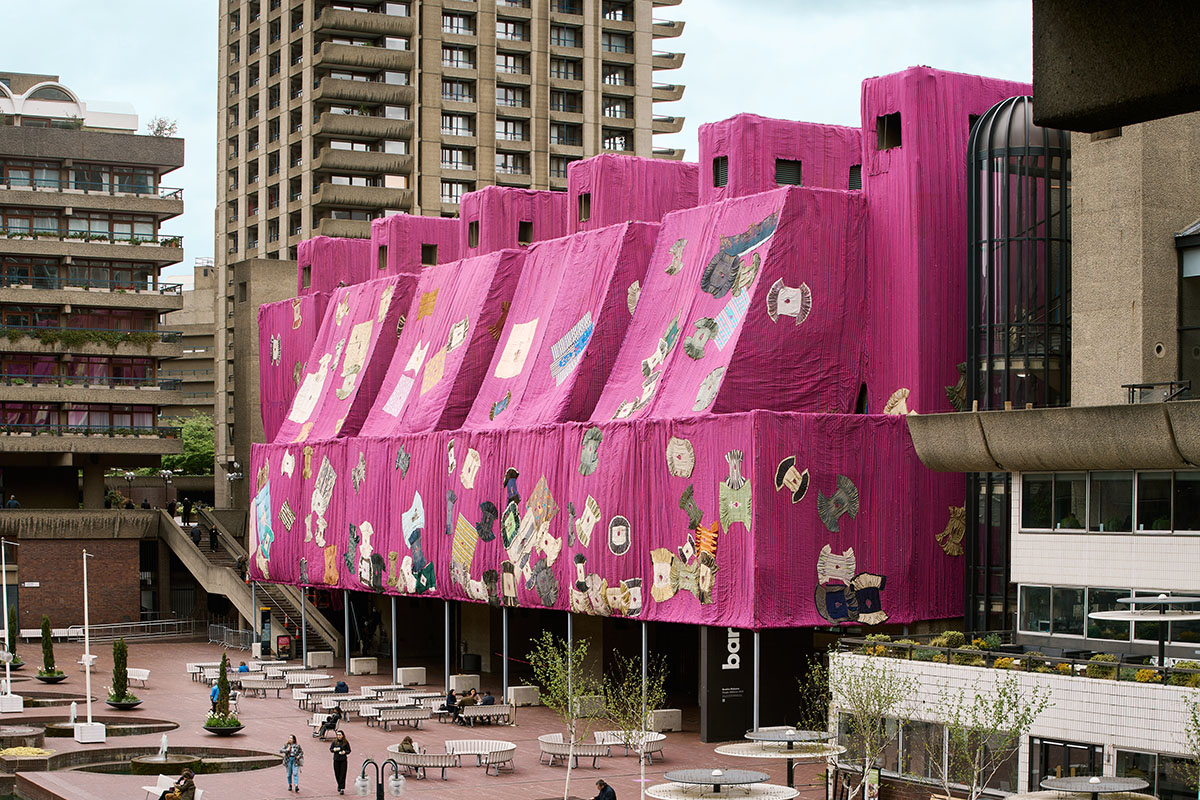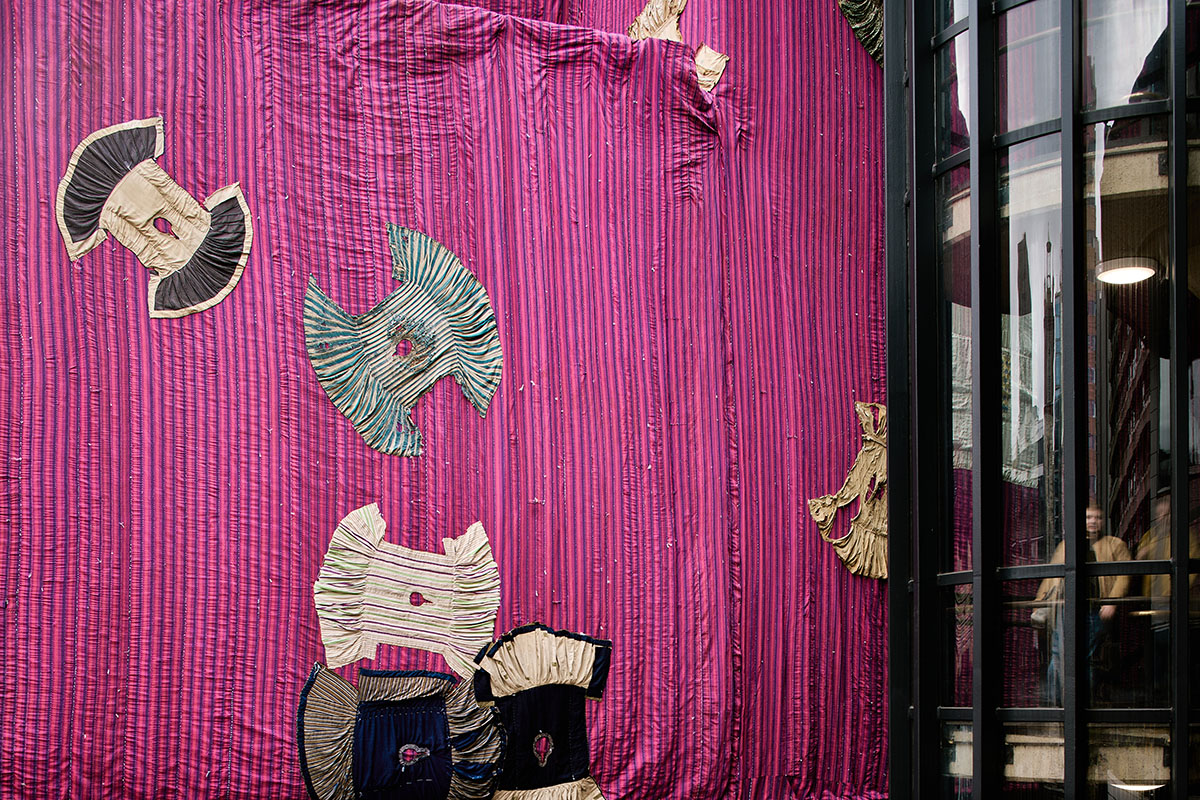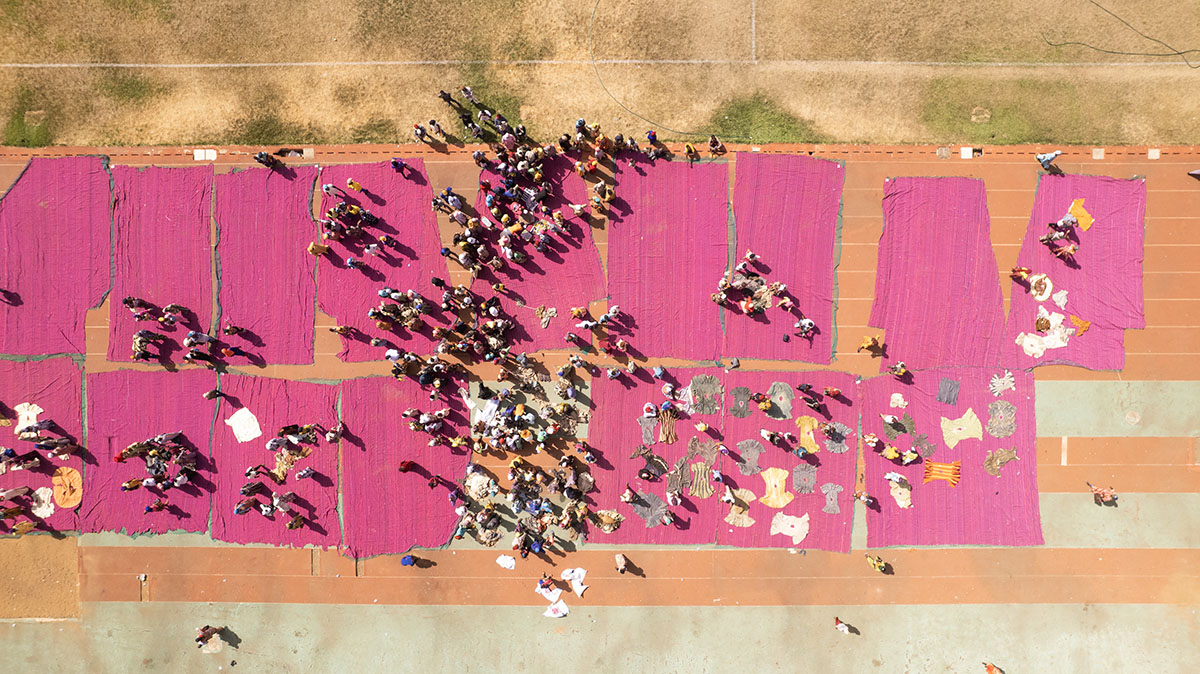Ghanaian Artist Ibrahim Mahama Wraps Barbican Centre With Handmade Pink Fabric

Ghanaian artist Ibrahim Mahama has wrapped the Barbican Centre in handmade pink fabric, transforming the iconic concrete exterior of the lakeside building in London, United Kingdom.
The installation, named Purple Hibiscus, represents the first large-scale UK public commission realized by Ghanaian artist Ibrahim Mahama, whose works "claim space, demand questions and enquiry, but also reflect solidarity with the craftspeople, weavers and makers in Ghana with whom he collaborates."
Changing the building’s iconic concrete exterior by using approximately 2,000 square metres of bespoke woven cloth, the installation can be visited from 10 April to 18 August 2024 at the Barbican Centre in London.

"Purple Hibiscus, named after Chimamanda Ngozi Adichie’s eponymous 2003 novel, is an ambitious new commission created in collaboration with hundreds of craftspeople from Tamale in Ghana," stated the Barbican Centre.
The artist's work was created by using large panels of pink and purple fabric, the panels were then hand-stitched to fit the Barbican's Lakeside façade.
Approximately 130 'batakaris' were embroidered into the fabric, and according to the Barbican Centre, Mahama collected them from various communities in Northern Ghana through a process of barter.
"These precious textiles, often saved by families over generations, tucked away in wardrobes or stored below beds, carry the imprints of the lives, lineage and power of the figures they once clothed," stated in a press release of the Barbican Centre.
"Worn and bearing traces of years of use, these smocks are testaments to the endurance of traditional belief systems, and the continued relevance of intergenerational knowledge."
"Incorporating these smocks into the commission carries forward Mahama’s deep interest in the life cycles of textiles and what can be learnt from the historical memories embedded within them," reads the press release.

"It’s like doing plastic surgery, but this time you require a soul that dwells within the body, which is immaterial to build on the physical material," said Ibrahim Mahama.
"Collecting the individual smocks from communities can be quite challenging, but also opens up a portal of new formal aesthetics. Using the Alui Mahama sports stadium in Tamale as the primary studio space for the production of Purple Hibiscus allowed for us to organise the different layers of the work in ways we couldn’t have possibly imagined."
"The scale of the material forms needed some level of freedom, which the space gifted," Mahama added.
Mahama collaborates with networks of women weavers and sewing collectives to produce Purple Hibiscus, which helps to support local economies.
He believes that the creation of his artworks should be linked to their local contexts and the lives of those communities. The vivid colors of this specific work differ from his usual palette, expressing solidarity with marginalized communities while also aiming to establish new alliances.

Mahama's monumental commission gains new resonance as it is transported to the Barbican's Lakeside Terrace.
The Barbican Centre is located on the former Cripplegate parish, which was largely destroyed during the Second World War.
"Following Ranjani Shettar’s exquisite commission for the Barbican Conservatory, we are thrilled to be presenting Purple Hibiscus by Ibrahim Mahama," said Shanay Jhaveri, Head of Visual Arts at the Barbican.
"At a time of increasing fracture and disharmony, Mahama, with this monumental site-specific artwork – the second in our newly launched commission series – will transform the Barbican’s iconic Lakeside into a site and space for the commemoration of community, intergenerational memory and solidarity, all achieved by the incredible capabilities and capacity of the human hand," Jhaveri added.

This area was known as a hub for the 'rag trade' in London, where buying, selling and production of cloth took place.
When viewed together, the hand-stitched panels of Purple Hibiscus and the hand-pitted concrete of the Barbican's rough concrete façade provide an expanded reflection on the relationship between the handcrafted and the monumental.
The Barbican commission coincides with the recent announcement of Ibrahim Mahama as the inaugural recipient of Dia’s Sam Gilliam Award, which includes a $75,000 gift and the presentation of a public programme at Dia Art Foundation in autumn 2024.

Purple Hibiscus 2023-24. Courtesy Ibrahim Mahama, Red Clay Tamale, Barbican Centre, London and White Cube Gallery

Purple Hibiscus 2023-24. Courtesy Ibrahim Mahama, Red Clay Tamale, Barbican Centre, London and White Cube Gallery
The Sam Gilliam Award is made possible by a generous gift from the Sam Gilliam Foundation.
Mahama is committed to building institutions that support the arts. His Red Clay Studio and Savannah Centre for Contemporary Art, located in Tamale, Ghana, provide social infrastructure for arts education, exhibitions, and residencies.
Mahama believes that everyone should have the opportunity to engage with art, not just those who have access to the exclusive art market.
All images © Dion Barrett / Barbican Centre unless otherwise stated.
> via Barbican Centre
